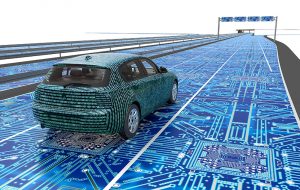- Connected cars and autonomous driving will make traffic flows more efficient and safer
- Edge Computing and intelligent freeways are the prerequisite
The end of the holidays after the long hot summer in the northern hemisphere will this year again result in traffic jams on freeways. But such predictable jams could soon be a thing of the past. “In a few years, connected driving will allow traffic to flow better even at peak times,” Klaus Landefeld, Board Member at eco – Association of the Internet Industry, is convinced. More and more cars are connected to each other and their environment over the Internet, they are capable of self-driving, and they make efficient and safe traffic flows possible. “The goal is to develop a traffic eco-system supported by Artificial Intelligence, in which vehicles can be permanently in motion,” Landefeld says.
But until we get there, there are technical hurdles to be overcome: “For connected cars to unfold their full potential, we need networks that fundamentally differ from those that we use today,” Landefeld continues. The mobile Internet is currently not broadly suitable to connect vehicles reliably and quickly so that they can communicate with each other and with the transport routes. Via the Internet protocol, vehicles will also potentially exchange information independently with traffic lights, road signs, and the street itself – for example, regarding road conditions, the current traffic situation, or road works.
Edge computing – computing power on the side of the road
A further challenge is the reaction time: To coordinate self-driving cars and control the flow of traffic, high levels of computing power are needed, which needs to be available quickly and reliably. “Transferring all data initially to a distant cloud data center, analyzing it there, and transferring the results back takes far too long. Every hundredth of a second counts,” according to Landefeld.
The solution is data centers near at hand, or along the street, which can do the calculations. This de-centralized data processing with storage possibilities and processing power at the edge of the network is termed “edge computing” by experts. “Autonomous driving requires the possibility for the load and back-end processing to happen on location – this is why edge computing is a key technology for autonomous cars,” Landefeld explains, and goes on: “What would be optimal is if processing could take place never more than 50 kilometers from the current location of the car – but for the German Autobahns alone we will need a substantial number of small data centers for the de-centralized processing of traffic data, and these would ideally also be provider-independently interconnected.”
Sensors in the asphalt
Alongside the cars, the streets will also need to be connected to the Internet of Things (IoT). For this, structural changes will be necessary, such as sensors in the asphalt, so that the transport routes themselves can communicate with the cars. “It is possible to integrate the sensors into the Internet of Things via narrow-band wide-area networks – these can then work for up to 10 or 15 years without needing a change of batteries.”
For more information on infrastructure for connected and self-driving cars, see the Klaus Landefeld interview on the topic in dotmagazine.




